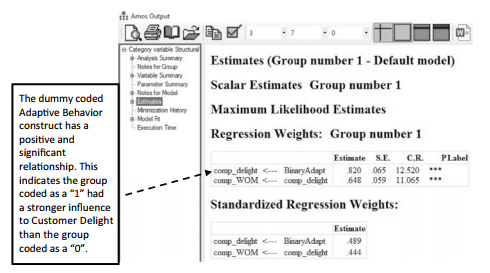AMOS has the assumption that the dependent variables are continuous, but you can use cat- egorical variables as independent constructs in an AMOS model. The only way this can be done is by dummy coding the categorical variable into a “0” and “1”. Once dummy coding takes place in SPSS, we can use this dichotomous variable in the analysis as an independent variable. Let’s go back to our path analysis example. In that example, we said that the construct of Adaptive Behavior will influence customers’ feelings of delight which influence Positive Word of Mouth.
![]()
Initially, in our path model example, Adaptive Behavior was measured on a 7-point Likert scale. Now, let’s say we performed an experiment and the employee either adapted the service experience for the customer (treatment) or they did not adapt the experience (control). After the experience, customers were asked questions about feelings of delight and intentions to spread word of mouth. In the data, all respondents who had an adapted service were coded as a “1”, and all respondents who did not receive an adapted ser- vice were coded as a “0”. The column label for this dummy coding is called “BinaryAdapt”. After the category variable has been dummy coded, we can set up the model in AMOS and run the analysis.

Figure 8.1 Binary Independent Variable Model
The output in the Estimates link (See Figure 8.2) shows us that the binary variable of Adaptive Behavior to Customer Delight is significant.The unstandardized estimate is .820. You don’t want to look at the standardized estimates with a dummy coded variable. Since the estimate is positive, this means that values coded as a 1 (employees adapted the service) had a stronger effect on Customer Delight than the group coded as a 0 (employees did not adapt the service). If the unstandardized coefficient was a negative, this would mean the group coded as a “0” had a stronger relationship to Customer Delight. To add greater con- text to these findings, the regression coefficient of the binary variable is nothing more than the mean difference of the Customer Delight construct across the groups. If you examine the mean of Customer Delight for the group that adapted the service and the group that did not adapt the service, the difference of those values is the regression coefficient of the binary variable in AMOS.

Figure 8.2 Estimates Output for Binary Independent Variable Model

Figure 8.3 Binary Independent Variable Regression Weight Based on Difference of Means
Source: Thakkar, J.J. (2020). “Procedural Steps in Structural Equation Modelling”. In: Structural Equation Modelling. Studies in Systems, Decision and Control, vol 285. Springer, Singapore.

28 Mar 2023
28 Mar 2023
31 Mar 2023
30 Mar 2023
21 Sep 2022
28 Mar 2023